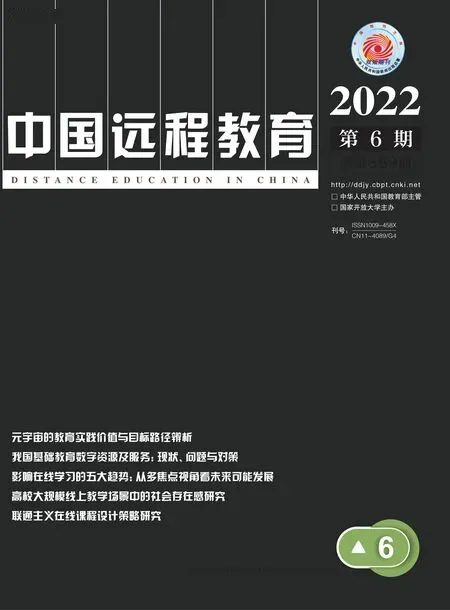Abstracts
Metaverse for education:practical value and development objectives
Liang Luo and Zhiting Zhu
As COVID-19 continues to plague the world,Metaverse has been seen as a driving force for innovation around the world.Building Digital China is among the priorities of China's 14th Five-Year Plan and Long-Range Objectives through the Year 2035.In response to this objective is the emergence of Education Informatization 2.0.The New Educational Infrastructure Movement is now underway to speed up the process.This article analyzes the core characteristics of Metaverse and its influence on human society development in four aspects.Drawing lessons from the Finnish KiVa Project and China’s Maker Education practice,it expounds on the value and feasibility of using Metaverse for education from the perspective of the philosophy of technology with the conclusion that Metaverse for education can be conducive to innovative educational informatization practices.It also argues for the construction of Metaverse for education in terms of objectives and conceptualization,technology,learning theory,data ownership,security and privacy protection,law and regulations,and sociocultural development.Suggestions are discussed on the implementation of Metaverse for education.
Keywords:Metaverse for education;educational informatization;New Educational Infrastructure Movement;next generation Internet;virtual learning space;philosophy of technology;embodied learning
China’s s basic education digital resources and services:status quo,problems and solutions
Mingxuan Chen,Zhiling Lai and Huiying Cai
This study set out to investigate China’s basic education digital resources and services.Using the methods of questionnaire survey and in-depth interview,the study investigated digital educational resources production and application in primary and secondary schools in 31 provinces and autonomous regions from the key player perspectives of educational administrators,teachers and students.It demonstrated the status quo of China’s basic education digital resources by identifying the extent to which and the ways in which these resources were used.The study also conducted a content analysis of data from 32 government-owned teaching resources platforms and 39 commercial teaching resources platforms with the aim of understanding services related to these resources in terms of construction management,service,resource co-construction and sharing,and effectiveness of service provided.Problems in supply and demand were identified and solutions were suggested.
Keywords:basic education;digital educational resources;educational resources service;educational resources allotment;educational digitalization;supply-side reform;resources construction by educational resources platforms
Five major trends shaping online learning:a multifocal view of possible fu-tures
Mark Brown,Eamon Costello and Enda Donlon
The COVID-19 crisis begs the question,what are the main trends in online learning?What might the future look like?While this paper does not set out to predict the future as this is best left to those who have a crystal ball,it does endeavor to provide a big picture helicopter view of the online learning field.It responds to the tendency to overlook the research literature during the pandemic and aims to help keep the future of online learning in the spotlight.The paper establishes that defining online learning is not a straightforward task,and there are widespread differences in the use of the term.A multifocal perspective is then adopted to identify five macro-level trends,which help frame the analysis from different angles and viewpoints.The discussion covers much ground and draws on a wide range of literature to illustrate how the digital education ecosystem is simultaneously converging,getting larger in scale,more open and closed,and is growing in diversity.Inherent tensions across these contradictory trends demonstrate how online learning needs to be understood in terms of wider societal change forces.Accordingly,the helicopter analysis attempts to steer a path between wider social issues,the language of opportunity,and the need for deeper criticality.Visible throughout the paper is the spirit of hope and the important role that educators play in shaping possible,probable,and preferred futures.
Keywords:online learning;COVID-19;future trends;hybrid learning;digital education ecosystem
Towards a measurement model of social presence in massive online teaching of higher education
Yechao Sun,Xuemei Li and Yunqiang Yang
As the result of the COVID-19 pandemic,higher education institutions(HEI)have significantly increased their use of online teaching to create flexible teaching environments,which,however,has also contributed to students’sense of isolation under the circumstances of physical separation.Enhancing social presence can effectively reduce students’negative experience in online teaching,fostering interaction and improving learning effectiveness.A measurement model of social presence was proposed which is composed of four dimensions:mutual respect,affective connectedness,open communication,and sense of community.A high-order factor analysis was made of the model.Findings show that the model is concise and comprehensive and can measure social presence in the four dimensions which need to be encouraged in online teaching of HEIs.It is also found that social presence has a complete mediating effect on the impact of platform ease of use on classroom interaction and a partial mediating effect on the impact of social clues on classroom interaction.It is argued that the existence of these mediating effects lends support to embedding social presence accounts into the discourse system of classroom.
Keywords:social presence;online teaching;higher education;measurement model;mediating effect;face-to-face teaching;COVID-19 pandemic;online teaching platform;teaching interaction;classroom interaction

